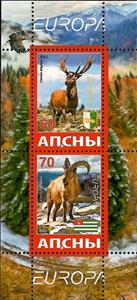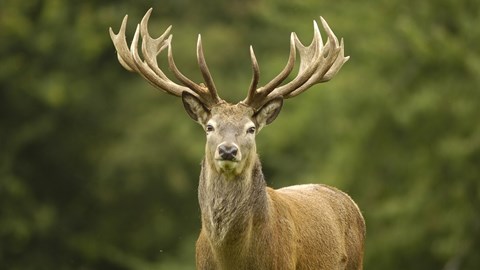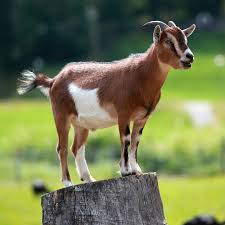Mini Sheet: EUROPA 2021 - Deer and Mountain Goat (Abkhazia 2021)
EUROPA 2021 - Deer and Mountain Goat (Abkhazia 2021)
01 January (Abkhazia ) within release EUROPA (2021) goes into circulation Mini Sheet EUROPA 2021 - Deer and Mountain Goat face value 130 Russian ruble
| Mini Sheet EUROPA 2021 - Deer and Mountain Goat in catalogues | |
|---|---|
| Colnect codes: | Col: AB 2021-37 |
Mini Sheet is square format.
This item has been denounced (in general) in Georgia 2012 UPU Circular 75 as illegally produced without the authorization of the postal administration. They have no postal validity. Please view Abkhazia stamps in the main stamp category to see validated stamp issues.Also in the issue EUROPA (2021):
- Mini Sheet - EUROPA 2021 - Deer and Mountain Goat face value 10*40;
- Stamp - EUROPA 2021 - Deer and Mountain Goat face value 40;
- Mini Sheet - EUROPA 2021 - Deer and Mountain Goat face value 10*55;
- Stamp - EUROPA 2021 - Deer and Mountain Goat face value 55;
- Mini Sheet - EUROPA 2021 - Deer and Mountain Goat face value 130;
|
Data entry completed
50%
|
|
|---|---|
| Mini Sheet EUROPA 2021 - Deer and Mountain Goat in digits | |
| Country: | Abkhazia |
| Date: | 2021-01-01 |
| Emission: | Illegal |
| Format: | Mini Sheet |
| Face Value: | 130 Russian ruble |
Mini Sheet EUROPA 2021 - Deer and Mountain Goat it reflects the thematic directions:
Animals are multicellular, eukaryotic organisms of the kingdom Animalia (also called Metazoa). All animals are motile, meaning they can move spontaneously and independently, at some point in their lives. Their body plan eventually becomes fixed as they develop, although some undergo a process of metamorphosis later on in their lives. All animals are heterotrophs: they must ingest other organisms or their products for sustenance.
A coat of arms is an heraldic visual design on an escutcheon (i.e. shield), surcoat, or tabard. The coat of arms on an escutcheon forms the central element of the full heraldic achievement which in its whole consists of shield, supporters, crest, and motto. A coat of arms is traditionally unique to an individual person, family (except in the United Kingdom), state, organisation or corporation.
A deer (pl.: deer) or true deer is a hoofed ruminant ungulate of the family Cervidae. It is divided into subfamilies Cervinae (which includes, among others, muntjac, elk (wapiti), red deer, and fallow deer) and Capreolinae (which includes, among others reindeer (caribou), white-tailed deer, roe deer, and moose). Male deer of almost all species (except the water deer), as well as female reindeer, grow and shed new antlers each year. These antlers are bony extensions of the skull and are often used for combat between males.
A flag is a piece of fabric (most often rectangular or quadrilateral) with a distinctive design that is used as a symbol, as a signaling device, or as decoration. The term flag is also used to refer to the graphic design employed, and flags have since evolved into a general tool for rudimentary signalling and identification, especially in environments where communication is similarly challenging (such as the maritime environment where semaphore is used). National flags are patriotic symbols with varied wide-ranging interpretations, often including strong military associations due to their original and ongoing military uses. Flags are also used in messaging, advertising, or for other decorative purposes. The study of flags is known as vexillology, from the Latin word vexillum, meaning flag or banner.
The goat or domestic goat (Capra hircus) is a species of domesticated goat-antelope that is mostly kept as livestock. It was domesticated from the bezoar ibex (C. aegagrus aegagrus) of Southwest Asia and Eastern Europe. The goat is a member of the family Bovidae, meaning it is closely related to the sheep. There are over 300 distinct breeds of goat. It is one of the oldest domesticated species of animal - according to archaeological evidence its earliest domestication occurred in Iran at 10,000 calibrated calendar years ago
Mammals are any vertebrates within the class Mammalia (/məˈmeɪli.ə/ from Latin mamma "breast"), a clade of endothermic amniotes distinguished from reptiles (including birds) by the possession of a neocortex (a region of the brain), hair, three middle ear bones and mammary glands. All female mammals nurse their young with milk, secreted from the mammary glands. Mammals include the largest animals on the planet, the great whales. The basic body type is a terrestrial quadruped, but some mammals are adapted for life at sea, in the air, in trees, underground or on two legs. The largest group of mammals, the placentals, have a placenta, which enables the feeding of the fetus during gestation. Mammals range in size from the 30–40 mm (1.2–1.6 in) bumblebee bat to the 30-meter (98 ft) blue whale. With the exception of the five species of monotreme (egg-laying mammals), all modern mammals give birth to live young. Most mammals, including the six most species-rich orders, belong to the placental group. The largest orders are the rodents, bats and Soricomorpha (shrews and allies). The next three biggest orders, depending on the biological classification scheme used, are the Primates (apes and monkeys), the Cetartiodactyla (whales and even-toed ungulates), and the Carnivora (cats, dogs, seals, and allies).






